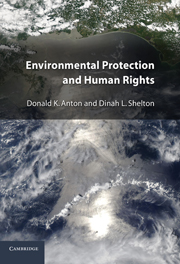Book contents
- Frontmatter
- Contents
- Acknowledgments
- Abbreviations
- Table of Cases
- 1 Law and the Environment
- 2 The Environment as a Human Rights Issue
- 3 An Introduction to Human Rights Origins and Theory
- 4 The International Protection of Human Rights
- 5 International Human Rights Institutions and Procedures
- 6 Procedural Human Rights and the Environment
- 7 Substantive Human Rights and the Environment
- 8 Indigenous Peoples, Rights, and the Environment
- 9 Humanitarian Crises: Armed Conflicts and Other Disasters
- 10 Environmental Rights and International Finance: The World Bank Example
- 11 Human Rights, the Environment, and Corporate Accountability
- Index
9 - Humanitarian Crises: Armed Conflicts and Other Disasters
Published online by Cambridge University Press: 05 June 2012
- Frontmatter
- Contents
- Acknowledgments
- Abbreviations
- Table of Cases
- 1 Law and the Environment
- 2 The Environment as a Human Rights Issue
- 3 An Introduction to Human Rights Origins and Theory
- 4 The International Protection of Human Rights
- 5 International Human Rights Institutions and Procedures
- 6 Procedural Human Rights and the Environment
- 7 Substantive Human Rights and the Environment
- 8 Indigenous Peoples, Rights, and the Environment
- 9 Humanitarian Crises: Armed Conflicts and Other Disasters
- 10 Environmental Rights and International Finance: The World Bank Example
- 11 Human Rights, the Environment, and Corporate Accountability
- Index
Summary
Introduction
Neither human rights nor environmental protection fare well during crises, whether the event is a tsunami or a civil war. Laws cannot prevent the former and have not succeeded in eliminating the latter. Law and policy can attempt, however, to minimize the harmful consequences of such catastrophes. The efforts to ameliorate the violent impact of armed conflict constitute the field of humanitarian law. And increasingly, the legal treatment of disasters outside of armed conflict has started to emerge, although it is probably too early to proclaim a field of international disaster law.
This chapter examines the problem of protecting the environment and the enjoyment of human rights in periods of crisis. It first considers the range of laws that aim to protect noncombatants and the environment during armed conflict, including issues of war crimes and accountability. It then turns to “natural” disasters, including industrial accidents of human origin. The final section concerns the rights of displaced persons, including environmental refugees. Before examining any of these issues, however, it is well to consider the similarities and differences between disasters and conflicts.
Natural Disaster and Conflict-Induced Displacement: Similarities, Differences, and Inter-Connections, BROOKINGS INSTITUTION (Mar. 27, 2008), available at http://www.brookings.edu/speeches/2008/0327_displacement_ferris.aspx
A Conceptual Problem
A natural disaster is defined by the U.N. as: “the consequences of events triggered by natural hazards that overwhelm local response capacity and seriously affect the social and economic development of a region.”
- Type
- Chapter
- Information
- Environmental Protection and Human Rights , pp. 666 - 778Publisher: Cambridge University PressPrint publication year: 2011

